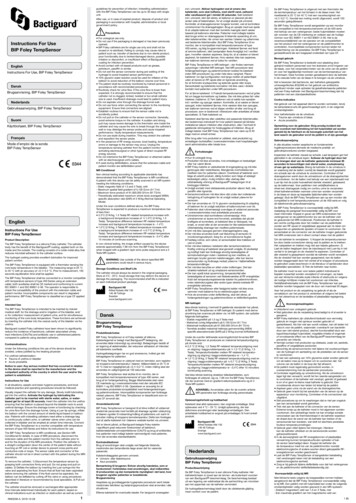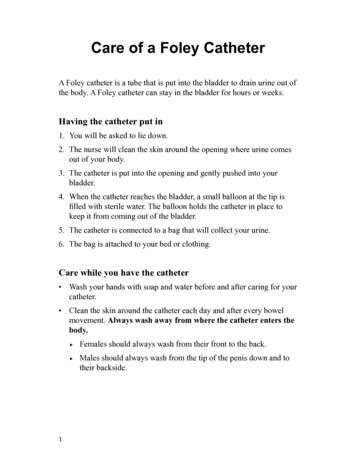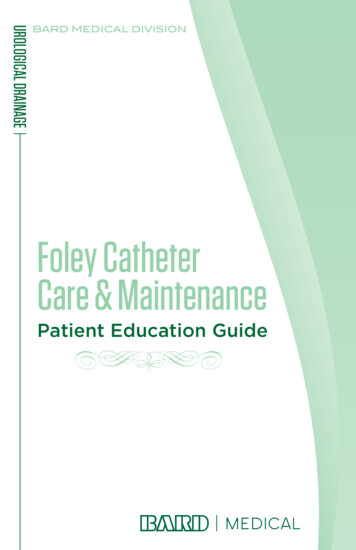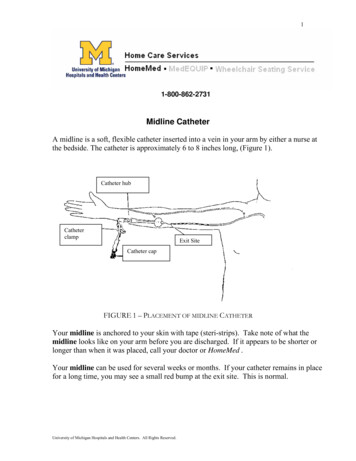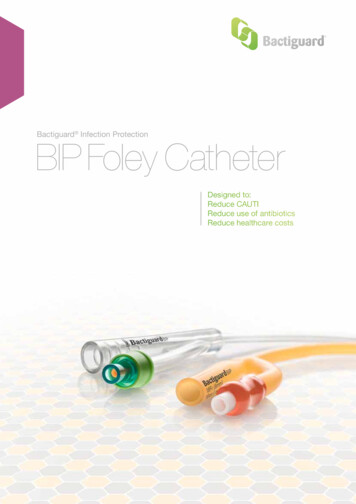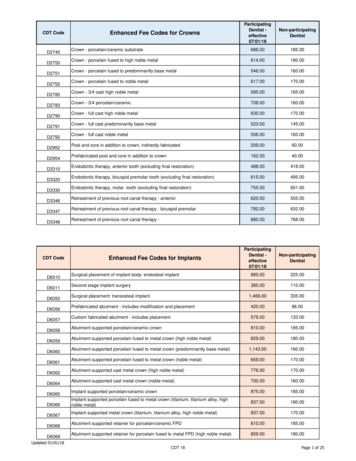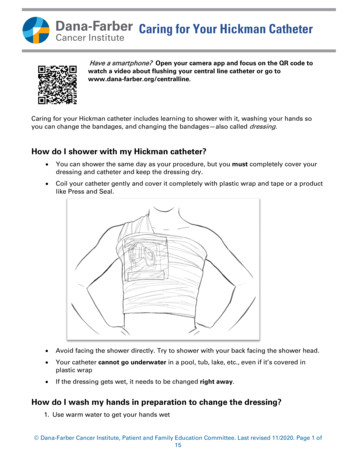
Transcription
Kai‑Larsen et al.Antimicrob Resist Infect Control(2021) n AccessRESEARCHFoley catheter with noble metal alloycoating for preventing catheter‑associatedurinary tract infections: a large, multi‑centerclinical trialYlva Kai‑Larsen1* , Stefan Grass1, Bhaumik Mody2, Swati Upadhyay3, Hargovind L. Trivedi4, Dilip. K. Pal5,Santosh Babu6, Bikash Bawari7 and Shrawan. K. Singh8AbstractBackground: Catheter-associated urinary tract infections (CAUTI) are among the most frequent healthcare-asso‑ciated infections in the world. They are associated with increased mortality, prolonged hospital stay and increasedhealthcare costs. The objective of this study was to evaluate the efficacy of the noble metal alloy (NMA) coated BIPFoley Catheter in preventing the incidence of symptomatic CAUTI in a large cohort of patients in India.Methods: This multi-center, prospective study included 1000 adult patients admitted to six hospitals across Indiafor urology, surgery and ICU requiring urethral catheterization and admission for 48 h. Patients were allocated tothe NMA-coated BIP Foley Catheter group or a non-coated control catheter group, with a randomization ratio of 3:1.CAUTI surveillance was conducted at study entry, upon catheter removal, and 2 days after catheter removal. For sta‑tistical analysis, categorical data (e.g. gender) were compared using the chi-square or Fischer test, and numerical datawere compared using the two-sample t-test. Associations were evaluated using logistic regression.Results and conclusions: The incidence of symptomatic CAUTI was reduced by 69% in the BIP Foley Catheter groupcompared to the control group (6.5 vs 20.8 CAUTI/1000 catheter days), with an incidence rate ratio of 0.31 (95%confidence interval: 0.21–0.46; p 0.001). A reduction in the cumulative CAUTI incidence was evident in the BIP FoleyCatheter group within 3 days after catheterization; this reduction was maintained up to 30 days, and the largestreductions were seen between 3 and 11 days. There were no serious adverse events related to either catheter, and thepercentage of patients with 1 adverse event was significantly lower in the NMA-coated BIP Foley Catheter groupthan in the control group (21.6% vs. 48.4%; p 0.001). In conclusion, the NMA-coated BIP Foley Catheter was effec‑tive in reducing CAUTI and was well tolerated, with a lower incidence of adverse events compared to the uncoatedcatheter.Trial registration This study was registered prospectively (28 September 2015) in the Clinical Trials Registry of India (trialnumber CTRI/2015/09/006220; http://ctri.nic.in/Clini caltr ials/showa llp.php?mid1 12631 &EncHi d &userN ame bacti guard ).*Correspondence: ylva.kai-larsen@bactiguard.com1Bactiguard AB, Alfred Nobels Allé 150, 146 48 Tullinge, Stockholm,SwedenFull list of author information is available at the end of the article The Author(s) 2021. Open Access This article is licensed under a Creative Commons Attribution 4.0 International License, whichpermits use, sharing, adaptation, distribution and reproduction in any medium or format, as long as you give appropriate credit to theoriginal author(s) and the source, provide a link to the Creative Commons licence, and indicate if changes were made. The images orother third party material in this article are included in the article’s Creative Commons licence, unless indicated otherwise in a credit lineto the material. If material is not included in the article’s Creative Commons licence and your intended use is not permitted by statutoryregulation or exceeds the permitted use, you will need to obtain permission directly from the copyright holder. To view a copy of thislicence, visit http://creat iveco mmons .org/licen ses/by/4.0/. The Creative Commons Public Domain Dedication waiver (http://creat iveco mmons .org/publi cdoma in/zero/1.0/) applies to the data made available in this article, unless otherwise stated in a credit line to the data.
Kai‑Larsen et al. Antimicrob Resist Infect Control(2021) 10:40Page 2 of 10Keywords: Catheter, Catheter-associated urinary tract infection, Foley, BIP foley catheter, Noble metal alloy, Coating,Infection controlIntroductionHealthcare-associated infections (HAI) are commonand represent a significant global burden of disease,with increased mortality, prolonged hospital stay andincreased healthcare costs [1–3]. The use of invasivedevices, such as urinary catheters, central lines andventilators, is associated with a high frequency of HAI.Since urinary catheters are the most commonly usedmedical device in the world, catheter-associated urinary tract infections (CAUTI) are among the most frequent HAI, with more than 150 million cases/year [4].Patients with CAUTI have prolonged hospital stays andadditional costs ranging between 876 and 10,197 areincurred [5–7]. CAUTI are often caused by multidrugresistant strains of bacteria, which are a global threatto human health [8]. In India, the incidence of CAUTIvaries between regions and hospitals, with intensivecare unit (ICU) rates of 4.4 CAUTI/1000 catheter daysand ward rates of 18 CAUTI/1000 catheter days havingbeen reported [9].According to the US Centers for Disease Control andPrevention (CDC), CAUTI are defined by a positiveurine culture (bacteriuria) together with at least onesymptom [10]. Bacteriuria occurs with a frequency of3–6%/day in catheterized patients [11], and, as well asthe chance of causing symptoms, there are risks of secondary bloodstream infection (bacteremia) and urosepsis (2% of CAUTI cases) [12].Risk factors for CAUTI include older age, femalegender, diabetes mellitus, and extended duration ofcatheterization. Many CAUTI are attributable to contamination of the catheter, either during insertion orduring use, when the drainage system may serve as asource of contamination [13].Evidence-based prevention strategies have beenintroduced to reduce the risk of CAUTI, and it is nowstandard practice to ensure sterility at the time of insertion, to use closed drainage systems, and to minimizethe duration of catheterization [14]. In addition, catheters coated with antiseptic and antimicrobial compounds such as silver ions, antibiotics, and noble metalalloys (NMAs) have been developed to reduce the riskof bacterial colonization [15–17]. One NMA-coatedlatex catheter (Bactiguard infection protection [BIP]Foley) has a non-releasing coating of gold, silver, andpalladium, and has been shown to reduce the incidenceof CAUTI in several settings (e.g. ICU, burn units,rehabilitation) [18–23]. However, a part of the availabledata are from small, non-randomized or retrospectivestudies performed without adherence to an accepteddefinition of CAUTI.We performed a study to assess the efficacy of theNMA-coated BIP Foley Catheter in reducing the riskof CAUTI among patients in India. The intention wasfor this to be the largest randomized controlled trial ofthis device, with adequate duration of catheterization( 2 days) and latency period post-catheterization, aswell as adherence to an accepted definition of CAUTI(i.e. that of the CDC).MethodsDesign and participantsThis was a prospective, multi-center, randomized, controlled study. Adults aged 18 years requiring urethralcatheterization (closed drainage system) for 48 h wereeligible for enrolment, provided they were being admitted to hospital for urology, surgery and an ICU stay. Candidate patients were excluded if they were pregnant orbreastfeeding, were receiving antibiotic treatment for aUTI or catheterization, had a latex allergy, or had undergone previous urinary tract surgery likely to interferewith the study results. The study was performed as part ofa post-marketing commitment in India, agreed betweenBactiguard AB (manufacturer of the BIP Foley Catheter)and the Center for Medical Device Evaluation at the Central Drugs Standard Control Organization. The study wasperformed in six hospitals spanning multiple regions ofIndia; (1) Apollo Hospitals International Limited (West),(2) Civil Hospital Campus, Ahmedabad (West)- (3)Chandigarh Hospital (North), (4) Kolkata Hospital (East),(5) Gandhi Hospital, Hyderabad (South) and (6) MarwariHospital, Guwahati (North-East). Approval of the studyprotocol was obtained from the Institutional ReviewBoard (i.e. ethical committee) at each participating hospital. The study was conducted according to the declaration of Helsinki (6th revision 2008), ISO 14155, andGood Clinical Practice clinical research requirements inIndia (CDCSO 2004).RandomizationA total of 1000 patients were randomly allocated in a3:1 ratio to two groups, one using the NMA-coated BIPFoley Catheter (Bactiguard Infection Protection, Bactiguard AB, Tullinge, Sweden) and the other using an
Kai‑Larsen et al. Antimicrob Resist Infect Control(2021) 10:40uncoated latex control catheter (Bardia; Bard / BectonDickinson, USA). In total 1003 patients fulfilled eligibility for participation in the study. However, two patientsdeclined participation before study start and one patientwas excluded due to delayed surgery and thus no need forcatheterization.Block randomization of eight patients per block wereused in 3:1 ratio, and no special adjustments or furtherstratification based on any patient characteristics wereperformed. The randomization code was generated usingStatistical Analysis Software (SAS), Version 9.3 (SASInstitute Inc., India). The laboratory evaluation testingPage 3 of 10was blinded, but study patients and healthcare professionals treating them were unblinded.ProceduresThe study included three evaluation timepoints: inclusioninto the study, catheter removal and 2 days after catheterremoval (Fig. 1). Catheters were removed according toguidelines/recommendations applicable to the patient’sclinical indication [13]. Urine samples were assessed by adipstick test, a pyuria test, and a urine culture test (standard microbiological testing). Patient safety assessmentsincluded vital signs, physical examination and laboratoryFig. 1 Study design. Three evaluation points were included: inclusion into the study, catheter removal and 2 days after catheter removalFig. 2 Definition of catheter–associated urinary tract infection (Centers for Disease Control and Prevention, National Healthcare Safety Network,2014)
Kai‑Larsen et al. Antimicrob Resist Infect Control(2021) 10:40tests performed according to standard hospital routines(Fig. 1).EndpointsThe primary endpoint was the incidence of symptomaticCAUTI, defined according to CDC criteria (2014). Thesecriteria included: onset of infection within 2 days afterremoval of catheter; catheterization time 2 days; bacterial growth of 105 or 103–105 CFU/ml in a urine specimen; a positive result from one of the following tests:dipstick for leukocyte-esterase or nitrate; Gram stain; orpyuria and at least one sign/symptom of CAUTI (Fig. 2).Secondary outcomes included numbers of spontaneousurinary and blood cultures, duration of hospitalization,and bacteriuria. Data were collected using electronic casereport forms (eCRFs) and audited to ensure consistency.No significant protocol violations were observed.Page 4 of 10Statistical analysisThe study size (i.e. 1000 patients) was specified by theCenter for Medical Device Evaluation within the postmarketing commitment for the BIP Foley Catheter. Consequently, no sample size calculation was performed.Results were analyzed on an “intention to treat” basisusing SAS (Version 9.3) and R (Version 3.6.3) and summarized using standard descriptive statistics. Categoricaldata (e.g. gender) were compared using the chi-squareor Fischer test, and numerical data (e.g. age, height andweight) were compared using the two-sample t-test.Associations were evaluated using logistic regression,with treatment arm as an independent variable and thelogarithm of catheter days as an offset. All p-values werecalculated two-sided and p-values less than 0.05 wereconsidered statistically significant.Fig. 3 Patient disposition. In total, 1000 patients were randomized and 901 patients completed the study. The distribution of patient types wassimilar in the two study groups
Kai‑Larsen et al. Antimicrob Resist Infect Control(2021) 10:40ResultsPatients were enrolled between December 2015 andApril 2018; 750 were randomized to receive the BIP FoleyCatheter and 250 were allocated to the control group(uncoated catheter). Nine hundred and one patientscompleted the study per protocol, and 99 patients (71in the BIP Foley Catheter group and 28 in the controlgroup) were withdrawn early (Fig. 3). Patients’ baselinecharacteristics (e.g. age, weight, height) were similar inPage 5 of 10both groups, although there was a small difference ingender distribution: in the BIP Foley Catheter arm, 235(31%) patients were female, compared with 101 (40%) inthe control arm. The mean duration of catheterization,11 days, was the same in both groups. The total number of catheterization days was 7,987 with the BIP FoleyCatheter and 2,551 with the control device. No statistically significant differences were observed in prophylactic antibiotic use (Table 1).Table 1 Baseline demographics and outcomes in the groups receiving noble metal coated catheter or uncoated control catheterBIP Foleyn 750Controln 250p-valueRelative reduction (RR) (%)Demographics and comorbiditiesAge, mean (SD)48 (15)47 (15)0.0908NAWeight, mean (SD)65 (34)69 (58)0.27NAHeight, mean (SD)161 (11)162 (9)0.39NASex, female, n (%)235 (31)101 (40)0.0106NADiabetes mellitus46 (6.1)19 (7.6)0.4NACancer5 (0.7)5 (2)0.07NADistribution of patients at each site and ward typeSite 1 General surgery and ICU102 (14)34 (14)NANASite 2 Urology6 (1)2 (1)NANASite 3 Urology96 (13)32 (13)NANASite 4 Urology228 (30)76 (30)NANASite 5 General surgery234 (31)78 (31)NANASite 6 Urology84 (11)28 (11)NANATotal General surgery and ICU336 (45)112 (45)NANATotal Urology414 (55)138 (55)NANACAUTICAUTI incidences (%) TOTAL52 (6.9)53 (21.2) 0.00167%CAUTI/1000 catheter days TOTAL6.5 (52/(7987 * 10 3))20.8 (53/(2551 days * 10 3)) 0.00169%General surgery and ICU (site 1 and 5)CAUTI/1000 catheter days12.3 (32/(2612 * 10 3))47.9 (37/(773 * 10 3)) 0.00170%Urology (site 2–4, 6)CAUTI/1000 catheter days3.7 (20/5375 * 10 3))9.0 (16/(1778 * 10 3))0.00658%BacteriuriaPositive growth at inclusion TOTAL n (%)30 (4)16 (6.4)0.11NAPositive growth TOTAL n (%)209 (28)161 (64) 0.00157%Positive growth, 105 CFU/ml n (%)89 (11.9)67 (26.8) 0.00156%Positive growth, 105 103, CFU/ml n (%)66 (8.8)53 (21.2) 0.00159%Antibiotics prophylaxis*, days/antibiotic treatedstudy patient8.28.50.54No significant differenceAntibiotics, catheterization days, hospitalAntibiotics prophylaxis, days/all study patients4.75.00.47No significant differenceDuration of catheterization, days11.110.90.79No significant differenceDuration of hospital admission, days6.56.30.59No significant differenceAdverse eventsTotal number of AE (%)162 (21.6%)121 (48.4%) 0.00155%Total patients with at least one AE n,112 (14.9%)80 (32.0%) 0.00153%*Antibiotics were received for other reasons than catheterization
Kai‑Larsen et al. Antimicrob Resist Infect Control(2021) 10:40Page 6 of 10abUncoated control60Uncoated controlNMA-coated BIP Foley Catheter*** p 0.00157%5015403067%69%******56%2010CAUTI (%)NMA-coated BIP Foley Catheter20CAUTI (%)70***59%5******10CAUTI/Bacteriuria (%) Bacteriuria (%) Total Bacteriuria (%)1000 cath days 105 103 105(detected)123456789 10 11 12 13 14 15 16 17 18 19 20 21 22 23 24 25 26 27 28 29 30 31 32 33Total no. of days of catheterizationcTotalMaleFemale 40 years40-60 years 60 yearsBMI 20BMI 20-24BMI 25-29BMI 300.010.10.31.010Incidence rate ratio (95% CI)Fig. 4 CAUTI incidence rates, for the whole study (a), over time (b) and in patient subgroups (c). Significant reductions were observed with theNMA-coated BIP Foley Catheter compared to the uncoated control catheterCAUTI incidenceSymptomatic CAUTI occurred during the study periodin 52/ 750 patients (6.9%) in the BIP Foley Cathetergroup, and 53/250 patients (21.2%) in the control group.Thus, the proportion of patients affected by CAUTI wasreduced by 67% in the BIP Foley Catheter group (oddsratio [OR] 0.28; 95% confidence interval [CI] 0.18–0.42;p 0.001; Table 1 and Fig. 4a). Similar results were seenwhen the duration of catheterization was taken intoconsideration: the incidence rates were 6.5 and 20.8CAUTI/1000 catheterization days in the two groupsrespectively, signaling a 69% reduction in CAUTI incidence with the BIP Foley Catheter (incidence rate ratio0.31; 95% CI 0.21–0.46; p 0.001; Fig. 4a).Cumulative CAUTI case counts were significantlyreduced in the BIP Foley Catheter group versus the control group as early as 3 days post-catheterization (i.e.total number of days of catheterization 2, see Fig. 4b),and this difference was maintained up to 30 days. Thebetween-group difference in cumulative cases was mostpronounced between 3 and 11 days (Fig. 4b).Subgroup analyses revealed that the BIP Foley Catheter reduced the CAUTI incidence rate regardless ofward type (urology versus surgery and ICU, see Table 1),patients’ gender, age or BMI, although the reduction wasnot statistically significant in patients aged 60 years orin those with BMI 20 (Fig. 4c).MicrobiologyA significantly lower proportion of patients in theBIP Foley Catheter group experienced bacteriuria( 105 CFU/ml) than in the control group: 89/750 (12%)versus 67/250 (27%). The relative reduction was 56%(p 0.001). Similar relative reductions of 50–60% wereobserved when bacteriuria was defined by lower bacterial counts (Fig. 4a). The four most common types ofinfection-causing organism were Escherichia coli, Klebsiella spp., Pseudomonas spp. and Enterococcus faecalis inboth study arms, and the infection rate for each one wasreduced significantly by the BIP Foley Catheter (Fig. 5).The infection rates for Enterococcus and the fungi Candida albicans were also significantly lower in the BIPFoley Catheter group than in the control group (Fig. 5).There was no spontaneous collection of urine or bloodsamples for culture testing in either study arm.
Kai‑Larsen et al. Antimicrob Resist Infect ControlUncoatedNMA-coated BIP Foley0510E. coli15202530***p 0.05(% of patients)***KlebsiellaPseudomonas(2021) 10:40***Gram bacteria***ProteusAcinetobacterE. FaecalisEnterococcus******S. AureusGram bacteriaS. AgalactiaeS. HaemolyticusC. TropicalisC. Albicans***Fungi (Candida)C. ParaspilosisFig. 5 Microbes that caused bacteriuria/CAUTI. Incidence rates formany strains were significantly reduced with the BIP Foley Cathetercompared to the uncoated control catheterSafetyAmong the whole study population (n 1000), 192patients reported 283 adverse events (AEs). Most of theAEs were attributable to CAUTI (e.g. suprapubic tenderness, costovertebral tenderness; Fig. 6). The percentageof patients with at least one AE was significantly lowerin the NMA-coated BIP Foley Catheter group than inthe control group (21.6% vs. 48.4%; p 0.001). Most AEswere mild, and there were no serious AEs related to thestudy devices or study-specific procedures.Hospital stayThe mean duration of hospitalization was 6.5 days inthe BIP Foley Catheter group and 6.3 days in the controlgroup (p not significant; Table 1).DiscussionThis randomized, multi-center, prospective clinicalstudy demonstrated a significant reduction of CAUTI inpatients receiving the NMA-coated BIP Foley Catheterversus an uncoated control catheter. A 60% reductionin bacteriuria translated to a 70% reduction in CAUTIPage 7 of 10incidence over the whole study period. The cumulativeincidence of CAUTI was significantly lower in the BIPFoley Catheter group between 3 and 30 days, showingthat the device is effective in both short- and mediumterm use. Importantly, this study did not reveal any safetyconcerns with the BIP Foley Catheter.There were no significant differences in the baselinecharacteristics of patients in the two arms of the study,except for the proportion of females being significantlylower in the BIP Foley Catheter arm than in the controlarm (31% vs 40%). Female gender is a known risk factor for CAUTI, but the subgroup analysis of our datademonstrated no interaction between the effectivenessof the BIP Foley Catheter and gender (Fig. 4c). The BIPFoley Catheter produced numerical reductions in theincidence of CAUTI in all analyzed subgroups (based onage and body mass index [BMI] as well as gender) and,in all except two of the subgroups (patients of old age[ 60 years] and those with low BMI [ 20]), these reductions were statistically significant. This suggests thatthe anti-infective effect of the BIP Foley Catheter is notrestricted to specific subgroups of patients, and that therobustness of our results was not reduced by the smallgender-related difference between the two study arms.The NMA coating of the BIP Foley Catheter is appliedto the inner and outer surface of the catheter shaft and tothe balloon and tip of the device, thereby minimizing thepotential for bacterial colonization and CAUTI. A recentcase study showed no significant release of metal into theurine, meaning that the device is non-toxic and does notfacilitate the development of resistance in bacteria [24].These are important considerations in patients requiringcatheterization for a long duration. The NMA coating ispostulated to have a galvanic mechanism of action whichdisturbs and prevents microbial adhesion to the surface.The results presented in Fig. 5 suggest that this is effectivein reducing urinary levels of a wide spectrum of microbesincluding gram( ) and gram( ) bacteria, fungi, and themost abundant uropathogenic species.To date, the present study is the largest randomized,multi-center study of an NMA-coated catheter to beperformed using an internationally accepted definition of CAUTI. The results are consistent with previousstudies showing positive outcomes with NMA-coatedcatheters, with reductions in the incidence of CAUTIbetween 35 and 90%, depending on the patient cohort,clinical setting and definition of CAUTI [11, 18–21, 24,25]. However, some of the earlier studies should be interpreted with a degree of caution because they were notwell-powered randomized controlled trials. One large,randomized study by Pickard et al. was performed tocompare a noble metal alloy-coated latex catheter with a
Kai‑Larsen et al. Antimicrob Resist Infect Control(2021) 10:40Page 8 of 10Fig. 6 Adverse events. The frequency of total adverse events was significantly lower in the BIP Foley Catheter group than in the control group.There was no significant between-group difference in AEs unrelated to CAUTI, most of which were also unrelated to the devicenitrofural-impregnated silicone catheter and a standardpolytetrafluoroethylene (PTFE) coated latex catheter inpatients requiring short-term catheterization ( 14 days)[26]. There were no significant between-group differences in the incidence of symptomatic CAUTI. However,the mean catheterization time of 2 days may have beentoo short for anti-infective effects to become apparent,and many patients would not have met the requirementfor catheterization time 2 days specified by the CDCwithin their definition of CAUTI. Also, as described
Kai‑Larsen et al. Antimicrob Resist Infect Control(2021) 10:40by Akre et al., the pragmatic methodology of this study(e.g. follow-up time for CAUTI surveillance was up to6 weeks) increased the risk of both false-positive andfalse-negative CAUTI results [27].Prevention of HAI is considered a global priority, withseveral initiatives from national and international organizations such as CDC and WHO. A recent systematicreview and meta-analysis by Schreiber et al. [28] reportedthat HAI reductions of 35–55% can be achieved withmultifaceted interventions. In one study, the implementation of multiple measures for preventing CAUTI (“5-SCAUTI bundle”, an approach that included education,catheter stabilization, correct positioning of the collection bag and daily evaluation) resulted in a statisticallysignificant 80% reduction in CAUTI rate [29]. This is inthe same range as the reduction achieved in the presentstudy with the NMA-coated BIP Foley Catheter (69%).On a practical level, implementation of the 5-S CAUTIbundle strategy would require considerable time andresource (e.g. for staff training and ensuring maintenanceof the required practices). Combined use of an NMAcoated catheter and measures included in the 5-S CAUTIbundle could be considered, as the different measures arelikely to complement one another.One limitation of our study was the short follow-upperiod after removal of the catheter; this meant that dataon antibiotic use for the treatment of CAUTI were notsufficient for analysis. Further limitations included thelack of blinding of the healthcare personnel involved inthe clinical assessment of CAUTI, and the potential forpatient-reported symptoms to be affected by subjective interpretations. On the other hand, performance ofthe study in India was a strength because this is a country with very high levels of antimicrobial resistance andproblems with infectious diseases. Background infection rates are much higher than in the developed world,increasing the chance of observing the effects of infection prevention measures. Another strength of the studywas the definition of CAUTI according to CDC criteria(2014): this ensured objective diagnosis and minimizedthe risk of bias.ConclusionsThis study confirms the efficacy of the NMA-coated BIPFoley Catheter in reducing the incidence of CAUTI andbacteriuria. The device was found to be well tolerated andno safety concerns were apparent. These data support useof the NMA-coated BIP Foley Catheter in clinical practice as a means of preventing CAUTI.Page 9 of 10AbbreviationsAE: Adverse event; BIP: Bactiguard infection protection; BMI: Body mass index;CAUTI: Catheter-associated urinary tract infections; CDC: Centers for DiseaseControl and Prevention; CI: Confidence interval; CTRI: Clinical Trials RegistryIndia; eCRF: Electronic case report form; HAI: Healthcare-associated infections;ICU: Intensive care unit; ISO: International organization for standardiza‑tion; NMA: Noble metal alloy; OR: Odds ratio; RR: Relative reduction; SAS:Statistical Analysis Software (SAS); UTI: Urinary tract infection.AcknowledgementsWe would like to thank Statisticon AB for statistical analyses, as well as DorotaJohansson and Frank Nylén for their contributions to the design and evalua‑tion of the study.Authors’ contributionsThe authors contributed to the development of this paper as describedbelow: Conception and design of the study: SKS, BM. Acquisition and analysisof data: BM, SU, HLT DKP, SB, BB, SKS. Statistical analysis BM, YKL, SG. Interpreta‑tion of the data: SKS, BM, YKL, SG. Drafting of the manuscript BM, YKL, SG. Criti‑cal revision of the manuscript: SKS, BM, YKL, SG. Administrative support: BM. Allauthors read and approved the final manuscript.FundingThis study was sponsored by Bactiguard AB.Availability of data and materialsThe datasets used and/or analyzed during the current study are available fromthe corresponding author on reasonable request.Ethics approval and consent to participateApproval of the study documentation was obtained from the Institu‑tional Review Board (i.e. ethical committee) at each participating hospital.Participants provided written, informed consent before any study-relatedprocedures were performed. For illiterate patients, a thumb-print signifyingverbal consent along with a signature from a legally acceptable representativewas obtained.Consent for publicationThe co-authors have agreed to allow the corresponding author to serve asthe primary correspondent with the editorial office, and to review the editedtypescript and proof for final publication.Competing interestsBactiguard was the sponsor of this study, and the authors SG and YKL areBactiguard employees/stock owners. No other authors have any conflict ofinterest to declare.Author details1Bactiguard AB, Alfred Nobels Allé 150, 146 48 Tullinge, Stockholm, Sweden.2Ethitrials Clinical Research Solution, Navrangpura, Ahmedabad, India. 3 ApolloHospitals International Limited, GIDC Estate, Bhat, India. 4 Institute of KidneyDiseases and Research Centre (IKDRC), Institute of Transplantation Sciences(ITS), B. J. Medical College and Civil Hospital Campus, Ahmedabad, Gujarat,India. 5 Institute of Post Graduate Medical Education and Research, Bose Road,Kolkata, India. 6 Department of General Surgery, Gandhi Hospital, Mush‑eerabad, Secunderabad, Telangana, India. 7 Marwari Hospital and ResearchCentre S.J. Road, Athagaon, Assam, India. 8 Department of Urology, Postgradu‑ate Institute of Medical Education and Research, Chandigarh, India.Received: 16 October 2020 Accepted: 10 February 2021References1. Glance LG, Stone PW, Mukamel DB, Dick AW. Increases in mortality, lengthof stay, and cost associated with hospital-acquired infections in traumapatients. Arch Surg. 2011;146(7):794–801.2. https ://apps.who.int/iris/bitst ream/handl e/10665 /80135 /97892 41501 507 eng.pdf?seque nce 1. World Health Organization. 2011.
Kai‑Larsen et al. Antimicrob Resist Infect 021) 10:40WHO Health care-associated infections FACT SHEET. 2020. https ://www.who.int/gpsc/count ry work/gpsc ccisc fact sheet en.pdf.Prevention CfDCa. http://www.cdc.gov/HAI/preve nt/preve ntion .html.Page last reviewed: November 13, 2015.Hollenbeak CS, Schilling AL. The attributable cost of catheter-associatedurinary tract infections in the United States: a systematic review. Am JInfect Control. 2018;46(7):751–7.Umscheid CA, Mitchell MD, Doshi JA, Agarwal R, Williams K, BrennanPJ. Estimating the proportion of healthcare-associated infections thatare reasonably preventable and the related mortality and costs. InfectControl Hosp Epidemiol. 2011;32(2):101–14.Gould CV, Umscheid CA, Agarwal RK, Kuntz G, Pegues DA, He
Keywords: Catheter, Catheter‑associated urinary tract infection, Foley, BIP foley catheter, Noble metal alloy, Coating, Infection control. Kai‑Larsen et al. Antimicrob Resist Infect Control Page 3 of 10 uncoated latex control catheter (Bardia; Bard / Becton Dickinson, USA). .
